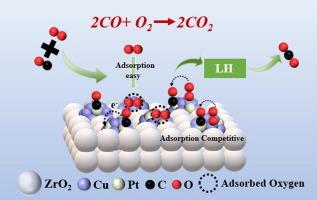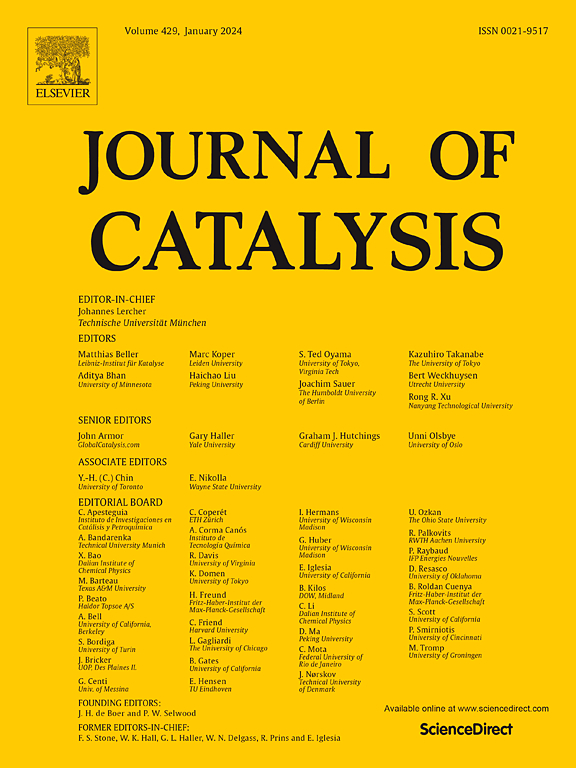Understanding the synergetic catalytic functions of Cu–Pt active sites in the bimetallic CuPt/ZrO2 catalyst in CO oxidation
IF 6.5
1区 化学
Q2 CHEMISTRY, PHYSICAL
引用次数: 0
Abstract
Catalytic oxidation processes for carbon monoxide (CO) typically rely on catalysts made from noble metals. However, due to the scarcity and high cost of noble metals, developing low–cost, highly active, and stable catalysts with low noble metal loading is highly demanded but challenging. Herein, we synthesized ZrO2–supported CuPt alloy nanoparticle (NP) catalyst (0.3Cu0.1Pt/ZrO2), with a Cu loading of 0.3 wt% and a Pt loading of 0.1 wt%, using a straightforward impregnation method. This catalyst structure enables the well-mixing of Cu and Pt atoms in the pristine and partially oxidized catalysts during the CO oxidation. The temperature for 0.3Cu0.1Pt/ZrO2 to reach 90 % CO conversion is 160 °C, which is much lower than those for 0.1Pt/ZrO2 (220 °C) and 0.4Cu/ZrO2 (195 °C). Extensive characterizations were conducted, particularly for the pristine catalysts. The experiments and density functional theory (DFT) calculations results reveal that the interaction between the two metals significantly modified the electronic property of the catalyst. On CuPt bimetallic sites, the electron transfer from Cu to Pt weakens the strong adsorption of CO, and Cu species provide sites for O2 adsorption, which synergistically promotes the CO oxidation on the surface of CuPt NPs. This research provides deep insights into the relationship between the catalyst structure and their catalytic performance and paves the way for developing highly active bimetallic synergistic catalysts for CO oxidation.

求助全文
约1分钟内获得全文
求助全文
来源期刊

Journal of Catalysis
工程技术-工程:化工
CiteScore
12.30
自引率
5.50%
发文量
447
审稿时长
31 days
期刊介绍:
The Journal of Catalysis publishes scholarly articles on both heterogeneous and homogeneous catalysis, covering a wide range of chemical transformations. These include various types of catalysis, such as those mediated by photons, plasmons, and electrons. The focus of the studies is to understand the relationship between catalytic function and the underlying chemical properties of surfaces and metal complexes.
The articles in the journal offer innovative concepts and explore the synthesis and kinetics of inorganic solids and homogeneous complexes. Furthermore, they discuss spectroscopic techniques for characterizing catalysts, investigate the interaction of probes and reacting species with catalysts, and employ theoretical methods.
The research presented in the journal should have direct relevance to the field of catalytic processes, addressing either fundamental aspects or applications of catalysis.
 求助内容:
求助内容: 应助结果提醒方式:
应助结果提醒方式:


